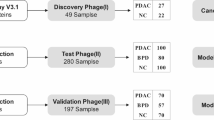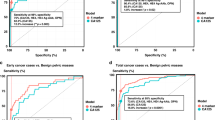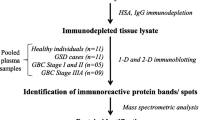Abstract
Purpose
CA-125 has been a valuable marker for detecting ovarian cancer, however, it is not sensitive enough to detect early-stage disease and not specific to ovarian cancer. The purpose of our study was to identify autoantibody markers that are specific to ovarian cancer regardless of CA-125 levels.
Methods
Top-down and iTRAQ quantitative proteomics methods were used to identify high-frequency autoantibodies in ovarian cancer. Protein microarrays comprising the recombinant autoantigens were screened using serum samples from various stages of ovarian cancer with diverse levels of CA-125 as well as benign and healthy controls. ROC curve and dot blot analyses were performed to validate the sensitivity and specificity of the autoantibody markers.
Results
The proteomics methodologies identified more than 60 potential high-frequency autoantibodies in ovarian cancer. Individual serum samples from ovarian cancer stages I–IV compared to control samples that were screened on a microarray containing native recombinant autoantigens revealed a panel of stage I high-frequency autoantibodies. Preliminary ROC curve and dot blot analyses performed with the ovarian cancer samples showed higher specificity and sensitivity as compared to CA-125. Three autoantibody markers exhibited higher specificity in various stages of ovarian cancer with low and normal CA-125 levels.
Conclusions
Proteomics technologies are suitable for the identification of protein biomarkers and also the identification of autoantibody biomarkers when combined with protein microarray screening. Using native recombinant autoantigen arrays to screen autoantibody markers, it is possible to identify markers with higher sensitivity and specificity than CA-125 that are relevant to early detection of ovarian cancer.






Similar content being viewed by others
References
Abendstein B, Marth C, Muller-Holzner E, Widschwendter M, Daxenbichler G, Zeimet AG (2000) Clinical significance of serum and ascitic p53 autoantibodies in epithelial ovarian carcinoma. Cancer 88(6):1432–1437
Aggarwal K, Choe LH, Lee KH (2005) Quantitative analysis of protein expression using amine-specific isobaric tags in Escherichia coli cells expressing rhsA elements. Proteomics 5(9):2297–2308
Anderson NL, Anderson NG (2002) The human plasma proteome: history, character, and diagnostic prospects. Mol Cell Proteomics 1(11):845–867
Anderson KS, LaBaer J (2005) The sentinel within: exploiting the immune system for cancer biomarkers. J Proteome Res 4(4):1123–1133
Blaes F, Klotz M, Huwer H, Straub U, Kalweit G, Schimrigk K, Schafers HJ (2000) Antineural and antinuclear autoantibodies are of prognostic relevance in non-small cell lung cancer. Ann Thorac Surg 69(1):254–258
Brichory FM, Misek DE, Yim AM, Krause MC, Giordano TJ, Beer DG, Hanash SM (2001) An immune response manifested by the common occurrence of annexins I and II autoantibodies and high circulating levels of IL-6 in lung cancer. Proc Natl Acad Sci USA 98(17):9824–9829
Burnham TK (1972) Antinuclear antibodies in patients with malignancies. Lancet 2(7774):436
Caiazzo RJ Jr, O’Rourke DJ, Barder TJ, Nelson BP, Liu BC (2011) Native antigen fractionation protein microarrays for biomarker discovery. Methods Mol Biol (Clifton, NJ) 723:129–148
Canelle L, Bousquet J, Pionneau C, Deneux L, Imam-Sghiouar N, Caron M, Joubert-Caron R (2005) An efficient proteomics-based approach for the screening of autoantibodies. J Immunol Methods 299(1–2):77–89. doi:10.1016/j.jim.2005.01.015
Caron M, Choquet-Kastylevsky G, Joubert-Caron R (2007) Cancer Immunomics Using Autoantibody Signatures for Biomarker Discovery. Mol Cell Proteomics 6(7):1115–1122
Chaib H, Rubin MA, Mucci NR, Li L, Taylor JMG, Day ML, Rhim JS, Macoska JA (2001) Activated in prostate cancer: a PDZ domain-containing protein highly expressed in human primary prostate tumors. Cancer Res 61(6):2390–2394
Chatterjee M, Mohapatra S, Ionan A, Bawa G, Ali-Fehmi R, Wang X, Nowak J, Ye B, Nahhas FA, Lu K, Witkin SS, Fishman D, Munkarah A, Morris R, Levin NK, Shirley NN, Tromp G, Abrams J, Draghici S, Tainsky MA (2006) Diagnostic markers of ovarian cancer by high-throughput antigen cloning and detection on arrays. Cancer Res 66(2):1181–1190
Chen S, LaRoche T, Hamelinck D, Bergsma D, Brenner D, Simeone D, Brand RE, Haab BB (2007) Multiplexed analysis of glycan variation on native proteins captured by antibody microarrays. Nat Methods 4(5):437–444. doi:10.1038/nmeth1035
Chen Z, Fadiel A, Feng Y, Ohtani K, Rutherford T, Naftolin F (2001) Ovarian epithelial carcinoma tyrosine phosphorylation, cell proliferation, and ezrin translocation are stimulated by interleukin 1alpha and epidermal growth factor. Cancer 92(12):3068–3075
Ehrlich JR, Qin S, Liu BC (2006) The ‘reverse capture’ autoantibody microarray: a native antigen-based platform for autoantibody profiling. Nat Protoc 1(1):452–460
Ferrini R (1997) Screening asymptomatic women for ovarian cancer: American College of Preventive Medicine practice policy. Am J Prev Med 13(6):444–446
Fossa A, Alsoe L, Crameri R, Funderud S, Gaudernack G, Smeland EB (2004) Serological cloning of cancer/testis antigens expressed in prostate cancer using cDNA phage surface display. Cancer Immunol Immunother 53(5):431–438
Gagnon A, Kim JH, Schorge JO, Ye B, Liu B, Hasselblatt K, Welch WR, Bandera CA, Mok SC (2008) Use of a combination of approaches to identify and validate relevant tumor-associated antigens and their corresponding autoantibodies in ovarian cancer patients. Clin Cancer Res Off J Am Assoc Cancer Res 14(3):764–771
Gautreau A, Louvard D, Arpin M (2002) ERM proteins and NF2 tumor suppressor: the Yin and Yang of cortical actin organization and cell growth signaling. Curr Opin Cell Biol 14(1):104–109
Gercel-Taylor C, Bazzett LB, Taylor DD (2001) Presence of aberrant tumor-reactive immunoglobulins in the circulation of patients with ovarian cancer. Gynecol Oncol 81(1):71–76
Gure AO, Altorki NK, Stockert E, Scanlan MJ, Old LJ, Chen YT (1998) Human lung cancer antigens recognized by autologous antibodies: definition of a novel cDNA derived from the tumor suppressor gene locus on chromosome 3p21.3. Cancer Res 58(5):1034–1041
Haab BB (2005) Antibody arrays in cancer research. Mol Cell Proteomics 4(4):377–383
Hanahan D, Weinberg RA (2000) The hallmarks of cancer. Cell 100(1):57–70
Hays JL, Kim G, Giuroiu I, Kohn EC (2010) Proteomics and ovarian cancer: integrating proteomics information into clinical care. J Proteomics 73(10):1864–1872
Hirasawa Y, Kohno N, Yokoyama A, Kondo K, Hiwada K, Miyake M (2000) Natural autoantibody to MUC1 is a prognostic indicator for non-small cell lung cancer. Am J Respir Crit Care Med 161(2 Pt 1):589–594
Hotulainen P, Paunola E, Vartiainen MK, Lappalainen P (2005) Actin-depolymerizing factor and cofilin-1 play overlapping roles in promoting rapid F-actin depolymerization in mammalian nonmuscle cells. Mol Biol Cell 16(2):649–664
Jager E, Chen YT, Drijfhout JW, Karbach J, Ringhoffer M, Jager D, Arand M, Wada H, Noguchi Y, Stockert E, Old LJ, Knuth A (1998) Simultaneous humoral and cellular immune response against cancer-testis antigen NY-ESO-1: definition of human histocompatibility leukocyte antigen (HLA)-A2-binding peptide epitopes. J Exp Med 187(2):265–270
Jemal A, Siegel R, Xu J, Ward E (2010) Cancer statistics. CA Cancer J Clin 60(5):277–300
Le Naour F, Brichory F, Misek DE, Brechot C, Hanash SM, Beretta L (2002) A distinct repertoire of autoantibodies in hepatocellular carcinoma identified by proteomic analysis. Mol Cell Proteomics 1(3):197–203
Levine AJ (1997) p53, the cellular gatekeeper for growth and division. Cell 88(3):323–331
Li M, Yin J, Mao N, Pan L (2013) Upregulation of phosphorylated cofilin 1 correlates with taxol resistance in human ovarian cancer in vitro and in vivo. Oncol Rep 29(1):58–66
Luborsky JL, Barua A, Shatavi SV, Kebede T, Abramowicz J, Rotmensch J (2005) Anti-tumor antibodies in ovarian cancer. Am J Reprod Immunol 54(2):55–62
Luo LY, Herrera I, Soosaipillai A, Diamandis EP (2002) Identification of heat shock protein 90 and other proteins as tumour antigens by serological screening of an ovarian carcinoma expression library. Br J Cancer 87(3):339–343
Maddison P, Newsom-Davis J, Mills KR, Souhami RL (1999) Favourable prognosis in Lambert-Eaton myasthenic syndrome and small-cell lung carcinoma. Lancet 353(9147):117–118
Mor G, Visintin I, Lai Y, Zhao H, Schwartz P, Rutherford T, Yue L, Bray-Ward P, Ward DC (2005) Serum protein markers for early detection of ovarian cancer. Proc Natl Acad Sci U S A 102(21):7677–7682
Mueller-Pillasch F, Lacher U, Wallrapp C, Micha A, Zimmerhackl F, Hameister H, Varga G, Friess H, Buchler M, Beger HG, Vila MR, Adler G, Gress TM (1997) Cloning of a gene highly over-expressed in cancer coding for a novel KH-domain containing protein. Oncogene 14(22):2729–2733
Naora H, Montz FJ, Chai CY, Roden RB (2001) Aberrant expression of homeobox gene HOXA7 is associated with mullerian-like differentiation of epithelial ovarian tumors and the generation of a specific autologous antibody response. Proc Natl Acad Sci USA 98(26):15209–15214
Nesterova M, Johnson N, Cheadle C, Cho-Chung YS (2006) Autoantibody biomarker opens a new gateway for cancer diagnosis. Biochim Biophys Acta 1762(4):398–403
Nishimura S, Tsuda H, Kataoka F, Arao T, Nomura H, Chiyoda T, Susumu N, Nishio K, Aoki D (2011) Over-expression of cofilin 1 can predict progression-free survival in patients with epithelial ovarian cancer receiving standard therapy. Hum Pathol 42(4):516–521
Nossov V, Amneus M, Su F, Lang J, Janco JM, Reddy ST, Farias-Eisner R (2008) The early detection of ovarian cancer: from traditional methods to proteomics. Can we really do better than serum CA-125? Am J Obstet Gynecol 199(3):215–223
Ohtani K, Sakamoto H, Rutherford T, Chen Z, Satoh K, Naftolin F (1999) Ezrin, a membrane-cytoskeletal linking protein, is involved in the process of invasion of endometrial cancer cells. Cancer Lett 147(1–2):31–38
Old LJ, Chen YT (1998) New paths in human cancer serology. J Exp Med 187(8):1163–1167
Partridge E, Kreimer AR, Greenlee RT, Williams C, Xu JL, Church TR, Kessel B, Johnson CC, Weissfeld JL, Isaacs C, Andriole GL, Ogden S, Ragard LR, Buys SS (2009) Results from four rounds of ovarian cancer screening in a randomized trial. Obstet Gynecol 113(4):775–782
Piver MS, Wong C (1998) Role of prophylactic surgery for women with genetic predisposition to cancer. Clin Obstet Gynecol 41(1):215–224
Polesello C, Delon I, Valenti P, Ferrer P, Payre F (2002) Dmoesin controls actin-based cell shape and polarity during Drosophila melanogaster oogenesis. Nat Cell Biol 4(10):782–789
Robinson C, Callow M, Stevenson S, Scott B, Robinson BW, Lake RA (2000) Serologic responses in patients with malignant mesothelioma: evidence for both public and private specificities. Am J Respir Cell Mol Biol 22(5):550–556
Rosen DG, Wang L, Atkinson JN, Yu Y, Lu KH, Diamandis EP, Hellstrom I, Mok SC, Liu J, Bast RC Jr (2005) Potential markers that complement expression of CA-125 in epithelial ovarian cancer. Gynecol Oncol 99(2):267–277
Ross PL, Huang YN, Marchese JN, Williamson B, Parker K, Hattan S, Khainovski N, Pillai S, Dey S, Daniels S, Purkayastha S, Juhasz P, Martin S, Bartlet-Jones M, He F, Jacobson A, Pappin DJ (2004) Multiplexed protein quantitation in Saccharomyces cerevisiae using amine-reactive isobaric tagging reagents. Mol Cell Proteomics 3(12):1154–1169
Sahin U, Tureci O, Schmitt H, Cochlovius B, Johannes T, Schmits R, Stenner F, Luo G, Schobert I, Pfreundschuh M (1995) Human neoplasms elicit multiple specific immune responses in the autologous host. Proc Natl Acad Sci USA 92(25):11810–11813
Sasaroli DCG, Scholler N (2009) Beyond CA-125: the coming of age of ovarian cancer biomarkers. Are we there yet? Biomark Med 3:275–288
Shetty V, Hafner J, Shah P, Nickens Z, Philip R (2012) Investigation of ovarian cancer associated sialylation changes in N-linked glycopeptides by quantitative proteomics. Clin Proteomics 9(1):10
Song J, Fadiel A, Edusa V, Chen Z, So J, Sakamoto H, Fishman DA, Naftolin F (2005) Estradiol-induced ezrin over-expression in ovarian cancer: a new signaling domain for estrogen. Cancer Lett 220(1):57–65
Soussi T (2000) p53 Antibodies in the sera of patients with various types of cancer: a review. Cancer Res 60(7):1777–1788
Suzuki H, Akakura K, Igarashi T, Ueda T, Ito H, Watanabe M, Nomura F, Ochiai T, Shimada H (2004) Clinical usefulness of serum antip53 antibodies for prostate cancer detection: a comparative study with prostate specific antigen parameters. J Urol 171(1):182–186
Tan EM (1991) Autoantibodies in pathology and cell biology. Cell 67(5):841–842
Tan EM, Chan EK, Sullivan KF, Rubin RL (1988) Antinuclear antibodies (ANAs): diagnostically specific immune markers and clues toward the understanding of systemic autoimmunity. Clin Immunol Immunopathol 47(2):121–141
Taylor DD, Gercel-Taylor C (1998) Tumor-reactive immunoglobulins in ovarian cancer: diagnostic and therapeutic significance? (review). Oncol Rep 5(6):1519–1524
Taylor DD, Gercel-Taylor C, Parker LP (2009) Patient-derived tumor-reactive antibodies as diagnostic markers for ovarian cancer. Gynecol Oncol 115(1):112–120
Vogelstein B, Kinzler KW (1993) The multistep nature of cancer. Trends Genet 9(4):138–141
Vogl FD, Stickeler E, Weyermann M, Kohler T, Grill HJ, Negri G, Kreienberg R, Runnebaum IB (1999) p53 autoantibodies in patients with primary ovarian cancer are associated with higher age, advanced stage and a higher proportion of p53-positive tumor cells. Oncology 57(4):324–329
Vogl FD, Frey M, Kreienberg R, Runnebaum IB (2000) Autoimmunity against p53 predicts invasive cancer with poor survival in patients with an ovarian mass. Br J Cancer 83(10):1338–1343
von Mensdorff-Pouilly S, Petrakou E, Kenemans P, van Uffelen K, Verstraeten AA, Snijdewint FG, van Kamp GJ, Schol DJ, Reis CA, Price MR, Livingston PO, Hilgers J (2000) Reactivity of natural and induced human antibodies to MUC1 mucin with MUC1 peptides and n-acetylgalactosamine (GalNAc) peptides. Int J Cancer 86(5):702–712
Wang X, Yu J, Sreekumar A, Varambally S, Shen R, Giacherio D, Mehra R, Montie JE, Pienta KJ, Sanda MG, Kantoff PW, Rubin MA, Wei JT, Ghosh D, Chinnaiyan AM (2005) Autoantibody signatures in prostate cancer. N Engl J Med 353(12):1224–1235
Yamaguchi H, Lorenz M, Kempiak S, Sarmiento C, Coniglio S, Symons M, Segall J, Eddy R, Miki H, Takenawa T, Condeelis J (2005) Molecular mechanisms of invadopodium formation: the role of the N-WASP-Arp2/3 complex pathway and cofilin. J Cell Biol 168(3):441–452
Yamamoto A, Shimizu E, Ogura T, Sone S (1996) Detection of auto-antibodies against L-myc oncogene products in sera from lung cancer patients. Int J Cancer 69(4):283–289
Yap CT, Simpson TI, Pratt T, Price DJ, Maciver SK (2005) The motility of glioblastoma tumour cells is modulated by intracellular cofilin expression in a concentration-dependent manner. Cell Motil Cytoskelet 60(3):153–165
Zhang JY, Casiano CA, Peng XX, Koziol JA, Chan EK, Tan EM (2003) Enhancement of antibody detection in cancer using panel of recombinant tumor-associated antigens. Cancer Epidemiol Biomarkers Prev 12(2):136–143
Zhang Z, Bast RC Jr, Yu Y, Li J, Sokoll LJ, Rai AJ, Rosenzweig JM, Cameron B, Wang YY, Meng XY, Berchuck A, Van Haaften-Day C, Hacker NF, de Bruijn HW, van der Zee AG, Jacobs IJ, Fung ET, Chan DW (2004) Three biomarkers identified from serum proteomic analysis for the detection of early stage ovarian cancer. Cancer Res 64(16):5882–5890
Zhu B, Fukada K, Zhu H, Kyprianou N (2006) Prohibitin and cofilin are intracellular effectors of transforming growth factor beta signaling in human prostate cancer cells. Cancer Res 66(17):8640–8647
Acknowledgments
This work was supported by USAMRAA Grant W81XWH-10-1-0307.
Conflict of interest
No actual or potential conflict of interest in relation to this article exists.
Author information
Authors and Affiliations
Corresponding author
Electronic supplementary material
Below is the link to the electronic supplementary material.
Rights and permissions
About this article
Cite this article
Karabudak, A.A., Hafner, J., Shetty, V. et al. Autoantibody biomarkers identified by proteomics methods distinguish ovarian cancer from non-ovarian cancer with various CA-125 levels. J Cancer Res Clin Oncol 139, 1757–1770 (2013). https://doi.org/10.1007/s00432-013-1501-6
Received:
Accepted:
Published:
Issue Date:
DOI: https://doi.org/10.1007/s00432-013-1501-6




